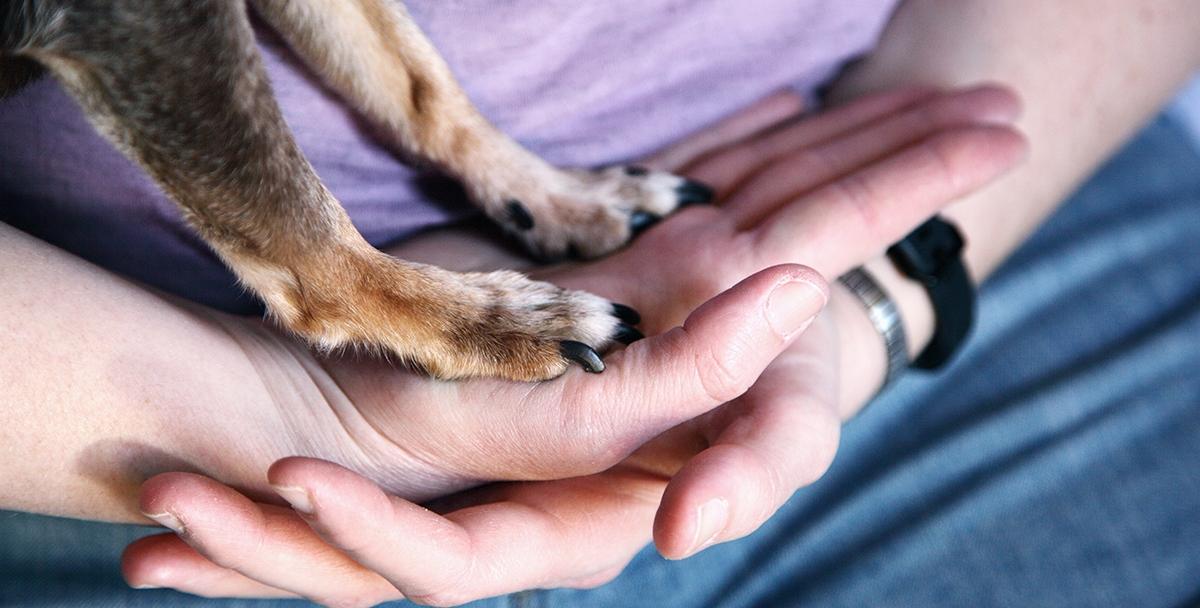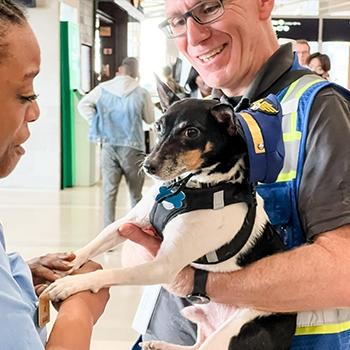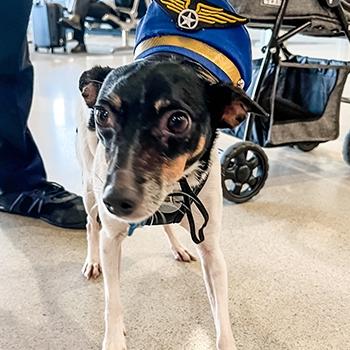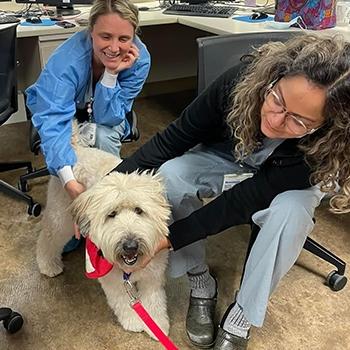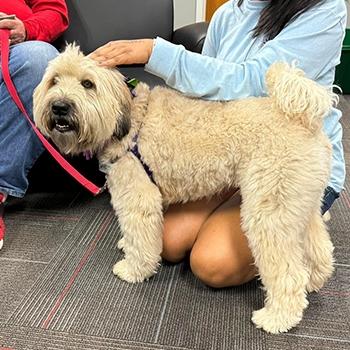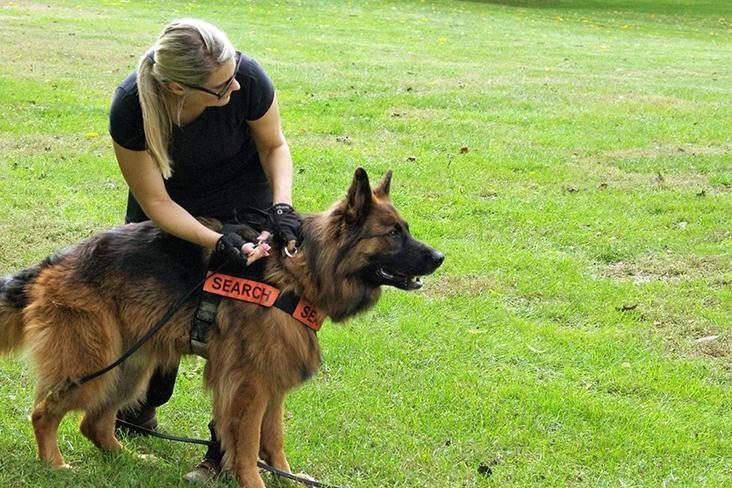Could Your Pooch Be a Therapy Dog?
By Kristi Valentini
Together, you and your pup could make a difference in the lives of others.
Waking my teen daughter, who was struggling with anxiety and desperately trying to avoid going to school, had become a challenge. Back rubs, bright lights and shouting “good morning” didn’t work, and yelling just created more stress. One day, when I was all out of ideas, in marched our four-legged family member. Penny, a rescued beagle mix, knew exactly what to do.
Penny could rouse my daughter and get her motivated better than anyone. Using her snout, Penny would burrow under my daughter’s arm and then whine and groan and roll around on her back until my teen gave her belly rubs. On the toughest mornings, Penny’s fail-safe method was placing her cold, wet nose on my teen’s face.
Once Penny garnered enough attention, she’d hop off the bed leaving my now smiling daughter ready to face the day.
According to John Palladino, a director for Therapaws of Michigan and certified pet handler, Penny might make an excellent therapy dog. Throughout history, canines have aided their human companions in various roles, and recent studies have shown their ability to boost people’s moods.
Therapy dogs and their owners volunteer to visit various places, from hospitals to nursing homes to schools and airports. They offer individuals the chance to connect with a friendly dog and take a mental breather.
“Therapy dogs are not service dogs,” clarifies the American Kennel Club. “Service dogs are specially trained to perform specific tasks to help a person with a disability,” such as guiding someone who is blind. They are also different from a police-trained dog that is given special tasks in detection, patrol or tracking.
“Seeing and interacting with dogs helps your brain quickly shift gears from whatever you were ruminating on to being present with the canine,” says Palladino. As a professor of special education at Eastern Michigan University, Palladino also studies the benefits of pet therapy in the classroom.
“The research is very clear on the effectiveness of pet therapy for children with anxiety and depression. In fact, just witnessing another person and dog interact across the room can normalize a person’s blood pressure, heart rate, and stress hormones,” he says.
Palladino says Therapaws often has more requests for therapy dogs than they can fulfill. So if you’re looking for a fun way to bond with your pet and make a positive impact in your community, volunteering to do pet therapy is a great option.
Would Your Pooch Make a Good Therapy Dog?
Therapy work is open to every kind of dog: purebred, mutt, young or old. Dogs need to be at least 1 year old and physically able to get around (or happy to sit in a stroller).
“We’re looking at the individual temperament of the dog. They should be stable, calm, able to settle easily and love to be petted,” says Steve Calcagno, board member and evaluator for Bright & Beautiful Therapy Dogs.
The general consensus is that having the right personality for therapy work is crucial. But good manners matter too. Can your dog sit, stay and come when called? Does your dog walk nicely on the leash without pulling and greet people without jumping on them? If not, your pup can still be a therapy dog with a little additional training.
An easy way to tell if your dog is ready for testing is to go to a store that allows dogs – oftentimes hardware stores do – or walk your dog downtown. It’s a good way to see if your dog enjoys interactions with strangers and can handle startling situations, such as kids running by, in a calm way. But Palladino advises against assessing your dog’s responses in a pet store because the scents of other dogs may cause your pet to get defensive or behave differently than he or she might otherwise.
What Are the Training and Certification Requirements?
Dogs and their handlers (owners) are certified as a team. You can request an evaluation without any official training. It’s up to you to decide if you think your dog is ready for the assessment, says Palladino. “What you do to get ready to pass the evaluation is up to you. Some people take the American Kennel Club’s Canine Good Citizen® training classes. Others train their dogs themselves or hire a trainer.”
The evaluation is typically a multipart assessment to see how well your dog takes direction from you and how your dog responds to strangers, other dogs, and various situations like loud noises. During the assessment, the evaluator may suggest areas to improve upon or let you know if your dog seems like a natural fit for a certain type of pet therapy.
How Do You Start Volunteering?
Getting started is simple. Contact one of the American Kennel Club’s recognized therapy dog organizations near you to learn their requirements for volunteering. They can recommend local training programs and the organization they want you to receive certification from.
Volunteering is typically a low-key commitment, depending on what you want to do. It can range from participating in occasional special events, such as final exams week at universities, to volunteering regularly once or twice a week. But the impact you make is more than you realize, says Palladino, who has had people schedule their medical appointments around when his dog will be at the hospital. “When I’m volunteering, people who interact with my dogs always say to me, ‘You have no idea how much I needed this.’”
Search-and-Rescue Dogs
Search-and-rescue dogs also perform an important community service, but the investment of time and money is higher than what is required for a therapy dog. The work is performed strictly on a voluntary basis.
Fifteen years ago, Casandra Ulbrich, trailing instructor and co-founder of Wolverine State Search and Recovery, never imagined she’d be out searching for missing persons. It was her rambunctious puppy, a German shepherd named Jackson, who started her down the path. Jackson needed an outlet for his energy and intellect beyond the puppy training and agility classes they had already taken.
“Someone suggested we try search-and-rescue training, and we both became hooked on it,” says Ulbrich. “You develop an amazing bond with your canine – you can read your dog’s cues and know what they are sensing or feeling at a level most people will never experience.”
Becoming a search-and-rescue team with your dog takes dedication. You have to finance up to two years of weekly training and commit to making yourself available whenever the need arises. “If it’s a live search, let’s say a child wandered away from home, you could get a call at 2 o’clock in the morning,” Ulbrich says. “The expectation is that you go if you can because you could be the difference between life and death.”
Want to learn more? Visit Search and Rescue Dogs of the United States, National Search Dog Alliance or browse online for local search-and-rescue groups.
ABOUT THE AUTHOR
Kristi Valentini is a travel writer whose work has been featured in Woman’s Day, Good Housekeeping, Oprah Daily and more. She creates easy-to-use trip guides at Readymade Travel Plans for people who love taking a vacation but hate planning for it.

